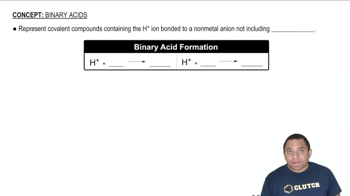Locate each of the following elements on the periodic table.
(f) Group 5A element that forms the strongest p bonds

 Verified step by step guidance
Verified step by step guidance



Locate each of the following elements on the periodic table.
(f) Group 5A element that forms the strongest p bonds
Look at the location of elements A, B, C, and D in the following periodic table:
Which hydride has the lowest boiling point?
In the following pictures of binary hydrides, ivory spheres
represent H atoms or ions, and burgundy spheres represent
atoms or ions of the other element.
(1)
(2)
(3)
(4)
(a) Identify each binary hydride as ionic, covalent, or interstitial.
(b) What is the oxidation state of hydrogen in compounds (1), (2), and (3)? What is the oxidation state of the other
element?
The following models represent the structures of binary hydrides of second-row elements:
b. Draw an electron-dot structure for each hydride. For which hydride is there a problem in drawing the structure? Explain.
The following pictures represent structures of the hydrides of four second-row elements:
(1)
(2)
(3)
(4)
(a) Which compound has the highest melting point?
The following pictures represent structures of the hydrides of four second-row elements:
(1)
(2)
(3)
(4)
(b) Which compound has the lowest boiling point?